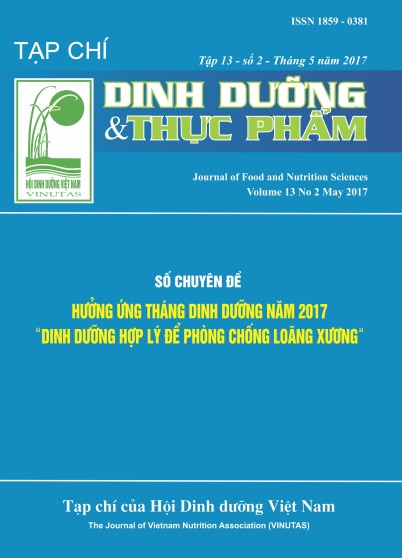REDUCING FASTING BLOOD GLUCOSE AND HbA1C IN METABOLIC SYNDROME PATIENT 55 – 70 YEARS OLD IN BAC NINH PROVINCE THROUGH USING GERMINATED RICE
Main Article Content
Abstract
Objective: A controlled clinical trial was conducted on 86 metabolic syndrome patients to evaluate the effect of germinated rice on the fasting blood glucose, HbA1c levels, Insulin and HOMA – Insulin index. Method: All subjects were divided into 2 groups, including the intervention group (using germinated rice 100 g/meal x 2 meal/day, during 12 weeks) and the control group. The levels of fasting blood glucose, HbA1c, Insulin were measured at baseline and after 12 weeks of the intervention. Results: R Results showed that after 3 months of the intervention, the blood glucose level and HbA1c level decreased significantly in the intervention group (p<0.05). The change in the blood glucose level was higher in the intervention group as compared with that of the control group (0.7 mmol/L versus 0.1 mmol/L; p <0.05). The HOMA- IR index of the intervention group were lower compared to that at baseline and compared to the control group (p <0.05). In addition, the prevalence of subjects with the blood glucose> 5.6 mmol/L and the prevalence of subjects with HbA1c>5.6% had a reducing trend in the intervention group (p> 0.05). Conclusion: The germinated rice is considered as the potential product to support in the prevention and treatment of metabolic syndrome in the elderly
Keywords
Blood glucose, HbA1c, metabolic syndrome, germinated rice
Article Details
References
2. Nguyễn Công Khẩn, Lê Bạch Mai và cộng sự. Tình trạng rối loạn lipid và một số giải pháp can thiệp ở người trưởng thành. Đề tài cấp nhà nước.
3. Charoenthaikij P1, Jangchud K, Jangchud A, Piyachomkwan K, Tungtrakul P, Prinyawiwatkul W (2009). Germination conditions affect physicochemical properties of germinated brown rice flour. J Food Sci, 74(9):C658-65.
4. Cáceres PJ1, Martínez-Villaluenga C, Amigo L, Frias J (2014). Assessment on proximate composition, dietary fiber, phytic acid and protein hydrolysis of germinated Ecuatorian brown rice. Plant Foods Hum Nutr, 69(3):261-7.
5. Wu F1, Yang N, Touré A, Jin Z, Xu X (2013). Germinated brown rice and its role in human health. Crit Rev Food Sci Nutr. ;53(5):451-63.
6. Mohan V1, Spiegelman D, Sudha V, Gayathri R, Hong B, Praseena K, Anjana RM, Wedick NM, Arumugam K, Malik V,Ramachandran S, Bai MR, Henry JK, Hu FB, Willett W, Krishnaswamy K (2014). Effect of brown rice, white rice, and brown rice with legumes on blood glucose and insulin responses in overweight Asian Indians: a randomized controlled trial. Diabetes Technol Ther, 16(5):317-25.
7. Imam MU1, Ismail M (2013). Nutrigenomic effects of germinated brown rice and its bioactives on hepatic gluconeogenic genes in type 2 diabetic rats and HEPG2 cells. Mol Nutr Food Res, Mar;57(3):401-11.
8. Sun Q1, Spiegelman D, van Dam RM, Holmes MD, Malik VS, Willett WC, Hu FB (2010). White rice, brown rice, and risk of type 2 diabetes in US men and women. Arch Intern Med, 170(11):961-9.
9. Hsu TF1, Kise M, Wang MF, Ito Y, Yang MD, Aoto H, Yoshihara R, Yokoyama J, Kunii D, Yamamoto S (2008). Effects of pre-germinated brown rice on blood glucose and lipid levels in free-living patients with impaired fasting glucose or type 2 diabetes. J Nutr Sci Vitaminol (Tokyo), 54(2):163-8.
10.Bui TN, Le TH, Nguyen do H, Tran QB, Nguyen TL, Le DT, Nguyen do VA, Vu AL, Aoto H, Okuhara Y, Ito Y, Yamamoto S, Kise M (2014). Pre-germinated brown rice reduced both blood glucose concentration and body weight in Vietnamese women with impaired glucose tolerance. J Nutr Sci Vitaminol (Tokyo), 60(3):183-7
Similar Articles
- Trịnh Thanh Xuân, Tuyet Mai TRUONG, Van Han PHAM, Thi Yen LE, Huu Bac NGUYEN, NUTRITION STATUS, DIETARY INTAKE OF WOMEN AGED 18-49 YEARS OLD IN TWO COMMUNES, TUAN GIAO DISTRICT, DIEN BIEN PROVINCE , Vietnam Journal of Nutrition & Food: Vol. 14 No. 6 (2018)
You may also start an advanced similarity search for this article.


